Physicochemical Analysis of Sediments Formed on the Surface of Hydrophilic Intraocular Lens after Descemet’s Stripping Endothelial Keratoplasty
Abstract
:1. Introduction
1.1. Medical Background
1.2. Physicochemical Analysis of Reported Cases
2. Experimental Details
2.1. Case Report
2.2. Sample Preparation
2.3. Applied Techniques
2.3.1. Atomic Force Microscopy (AFM)
2.3.2. The X-ray Photoelectron Spectroscopy (XPS)
2.3.3. Time of Flight Secondary Ion Mass Spectrometry (TOF–SIMS)
2.3.4. Experimental Procedures for the Spectroscopic Measurements
3. Results
3.1. Morphology
3.2. Chemical Composition
3.2.1. Surface Analysis by XPS
3.2.2. Morphology and Surface Analysis by TOF–SIMS
3.3. Sedimentation Mechanism
3.4. Potential Impact on Current Medical Practice
4. Conclusions
Supplementary Materials
Author Contributions
Funding
Conflicts of Interest
References
- Vasavada, A.R.; Raj, S.M.; Shah, A.; Shah, G.; Vasavada, V. Comparison of posterior capsule opacification with hydrophobic acrylic and hydrophilic acrylic intraocular lenses. J. Cataract. Refract. Surg. 2011, 37, 1050–1059. [Google Scholar] [CrossRef]
- Abela-Formanek, C.; Amon, M.; Kahraman, G.; Schauersberger, J.; Dunavoelgyi, R. Biocompatibility of hydrophilic acrylic, hydrophobic acrylic, and silicone intraocular lenses in eyes with uveitis having cataract surgery: Long-term follow-up. J. Cataract. Refract. Surg. 2011, 37, 104–112. [Google Scholar] [CrossRef] [PubMed]
- Giers, B.C.; Tandogan, T.; Auffarth, G.U.; Choi, C.Y.; Auerbach, F.N.; Sel, S.; Mayer, C.; Khoramnia, R. Hydrophilic intraocular lens opacification after posterior lamellar keratoplasty—A material analysis with special reference to optical quality assessment. BMC Ophthalmol. 2017, 17, 1–10. [Google Scholar] [CrossRef] [PubMed] [Green Version]
- Park, J.C.; Habib, N.E.; Moate, R.M. Intraocular lens calcification following endothelial keratoplasty: A message for all cataract surgeons. Eye 2015, 29, 984. [Google Scholar] [CrossRef] [PubMed] [Green Version]
- Neuhann, I.M.; Neuhann, T.F.; Rohrbach, J.M. Intraocular lens calcification after keratoplasty. Cornea 2013, 32, e6–e10. [Google Scholar] [CrossRef] [PubMed]
- Dhital, A.; Spalton, D.J.; Goyal, S.; Werner, L. Calcification in hydrophilic intraocular lenses associated with injection of intraocular gas. Am. J. Ophthalmol. 2012, 153, 1154–1160. [Google Scholar] [CrossRef]
- Werner, L.; Wilbanks, G.; Nieuwendaal, C.P.; Dhital, A.; Waite, A.; Schmidinger, G.; Lee, W.B.; Mamalis, N. Localized opacification of hydrophilic acrylic intraocular lenses after procedures using intracameral injection of air or gas. J. Cataract. Refract. Surg. 2015, 41, 199–207. [Google Scholar] [CrossRef]
- Fellman, M.A.; Werner, L.; Liu, E.T.; Stallings, S.; Floyd, A.M.; Van Der Meulen, I.J.; Lapid-Gortzak, R.; Nieuwendaal, C.P. Calcification of a hydrophilic acrylic intraocular lens after Descemet-stripping endothelial keratoplasty: Case report and laboratory analyses. J. Cataract. Refract. Surg. 2013, 39, 799–803. [Google Scholar] [CrossRef]
- Nieuwendaal, C.P.; Van Der Meulen, I.J.; Patryn, E.; Werner, L.; Mourits, M.P.; Lapid-Gortzak, R. Opacification of the intraocular lens after descemet stripping endothelial keratoplasty. Cornea 2015, 34, 1375–1377. [Google Scholar] [CrossRef]
- Ahad, M.A.; Darcy, K.; Cook, S.D.; Tole, D.M. Intraocular lens opacification after descemet stripping automated endothelial keratoplasty. Cornea 2014, 33, 1307–1311. [Google Scholar] [CrossRef]
- Price, J.F.W.; Price, M.O. Descemet’s stripping with endothelial keratoplasty in 50 eyes: A refractive neutral corneal transplant. J. Refract. Surg. 2005, 21, 339–345. [Google Scholar] [CrossRef] [PubMed]
- Gorovoy, M.S. Descemet-stripping automated endothelial keratoplasty. Cornea 2006, 25, 886–889. [Google Scholar] [CrossRef] [PubMed]
- Dagres, E.; Khan, M.A.; Kyle, G.M.; Clark, D. Perioperative complications of intraocular lens exchange in patients with opacified Aqua-Sense lenses. J. Cataract. Refract. Surg. 2004, 30, 2569–2573. [Google Scholar] [CrossRef] [PubMed]
- Morgan-Warren, P.J.; Andreatta, W.; Patel, A.K. Opacification of hydrophilic intraocular lenses after descemet stripping automated endothelial keratoplasty. Clin. Ophthalmol. 2015, 9, 277–283. [Google Scholar] [CrossRef] [Green Version]
- Gurabardhi, M.; Häberle, H.; Aurich, H.; Werner, L.; Pham, D.-T. Serial intraocular lens opacifications of different designs from the same manufacturer: Clinical and light microscopic results of 71 explant cases. J. Cataract. Refract. Surg. 2018, 44, 1326–1332. [Google Scholar] [CrossRef] [Green Version]
- Tandogan, T.; Khoramnia, R.; Choi, C.Y.; Scheuerle, A.; Wenzel, M.; Hugger, P.; Auffarth, G.U. Optical and material analysis of opacified hydrophilic intraocular lenses after explantation: A laboratory study. BMC Ophthalmol. 2015, 15, 170. [Google Scholar] [CrossRef] [Green Version]
- Yildirim, T.M.; Auffarth, G.U.; Łabuz, G.; Bopp, S.; Son, H.-S.; Khoramnia, R. Material analysis and optical quality assessment of opacified hydrophilic acrylic intraocular lenses after pars plana vitrectomy. Am. J. Ophthalmol. 2018, 193, 10–19. [Google Scholar] [CrossRef]
- Werner, L.; Stover, J.C.; Schwiegerling, J.; Das, K.K. Effects of intraocular lens opacification on light scatter, stray light, and overall optical quality/performance. Investig. Opthalmol. Vis. Sci. 2016, 57, 3239. [Google Scholar] [CrossRef]
- Barra, D.; Werner, L.; Costa, J.L.P.; Morris, C.; Ribeiro, T.; Ventura, B.V.; Dornelles, F. Light scattering and light transmittance in a series of calcified single-piece hydrophilic acrylic intraocular lenses of the same design. J. Cataract. Refract. Surg. 2014, 40, 121–128. [Google Scholar] [CrossRef]
- Michelson, J.; Werner, L.; Ollerton, A.; Leishman, L.; Bodnar, Z. Light scattering and light transmittance in intraocular lenses explanted because of optic opacification. J. Cataract. Refract. Surg. 2012, 38, 1476–1485. [Google Scholar] [CrossRef]
- Łabuz, G.; Yildirim, T.M.; Berg, T.J.V.D.; Khoramnia, R.; Auffarth, G.U. Assessment of straylight and the modulation transfer function of intraocular lenses with centrally localized opacification associated with the intraocular injection of gas. J. Cataract. Refract. Surg. 2018, 44, 615–622. [Google Scholar] [CrossRef] [PubMed] [Green Version]
- Werner, L. Calcification of hydrophilic acrylic intraocular lenses. Am. J. Ophthalmol. 2008, 146, 341–343. [Google Scholar] [CrossRef] [PubMed]
- Rahimi, M.; Azimi, A.; Hosseinzadeh, M. Intraocular lens calcification: Clinico-pathological report of two cases and literature review. J. Ophthalmic Vis. Res. 2018, 13, 195–199. [Google Scholar] [CrossRef] [PubMed]
- Yang, Y.; Peng, M.; Duan, Y.; Huang, X.; Li, K.; Lin, D. Opacification of a hydrophilic acrylic intraocular lens. J. Coll. Physicians Surg. Pak. 2017, 27, S58–S60. [Google Scholar] [PubMed]
- Neuhann, T.; Yildirim, T.M.; Son, H.-S.; Merz, P.R.; Khoramnia, R.; Auffarth, G.U. Reasons for explantation, demographics, and material analysis of 200 intraocular lens explants. J. Cataract Refract. Surg. 2020, 46, 20–26. [Google Scholar] [CrossRef] [PubMed]
- Rezaei-Kanavi, M.; Javadi, M.-A.; Mirbabaei-Ghafghazi, F. Intraocular Lens calcification; A clinicopathologic report. J. Ophthalmic Vis. Res. 2009, 4, 122–124. [Google Scholar] [PubMed]
- Pandey, S.K.; Werner, L.; Apple, D.J.; Kaskaloglu, M. Hydrophilic acrylic intraocular lens optic and haptics opacification in a diabetic patient. Ophthalmology 2002, 109, 2042–2051. [Google Scholar] [CrossRef]
- Werner, L.; Wilbanks, G.; Ollerton, A.; Michelson, J. Localized calcification of hydrophilic acrylic intraocular lenses in association with intracameral injection of gas. J. Cataract. Refract. Surg. 2012, 38, 720–721. [Google Scholar] [CrossRef]
- Gartaganis, S.P.; Kanellopoulou, D.G.; Mela, E.K.; Panteli, V.S.; Koutsoukos, P.G. Opacification of hydrophilic acrylic intraocular lens attributable to calcification: Investigation on mechanism. Am. J. Ophthalmol. 2008, 146, 395–403. [Google Scholar] [CrossRef]
- Guan, X.; Tang, R.; Nancollas, G.H. The potential calcification of octacalcium phosphate on intraocular lens surfaces. J. Biomed. Mater. Res. 2004, 71, 488–496. [Google Scholar] [CrossRef]
- Chirila, T.V.; Zainuddin; Hill, D.J.T.; Whittaker, A.K.; Kemp, A. Effect of phosphate functional groups on the calcification capacity of acrylic hydrogels. Acta Biomater. 2007, 3, 95–102. [Google Scholar] [CrossRef] [PubMed]
- Marcovich, A.L.; Tandogan, T.; Bareket, M.; Eting, E.; Kaplan-Ashiri, I.; Bukelman, A.; Auffarth, G.U.; Khoramnia, R. Opacification of hydrophilic intraocular lenses associated with vitrectomy and injection of intraocular gas. BMJ Open Ophthalmol. 2018, 3, e000157. [Google Scholar] [CrossRef] [PubMed] [Green Version]
- Dorey, M.W.; Brownstein, S.; Hill, V.E.; Mathew, B.; Botton, G.; Kertes, P.J.; El-Defrawy, S. Proposed pathogenesis for the delayed postoperative opacification of the hydroview hydrogel intraocular lens. Am. J. Ophthalmol. 2003, 135, 591–598. [Google Scholar] [CrossRef]
- Werner, L.; Hunter, B.; Stevens, S.; Chew, J.J.; Mamalis, N. Role of silicon contamination on calcification of hydrophilic acrylic intraocular lenses. Am. J. Ophthalmol. 2006, 141, 35–43. [Google Scholar] [CrossRef] [PubMed]
- Neuhann, I.M.; Kleinmann, G.; Apple, D.J. A New classification of calcification of intraocular lenses. Ophthalmology 2008, 115, 73–79. [Google Scholar] [CrossRef]
- Balendiran, V.; MacLean, K.; Mamalis, N.; Tetz, M.; Werner, L. Localized calcification of hydrophilic acrylic intraocular lenses after posterior segment procedures. J. Cataract. Refract. Surg. 2019, 45, 1801–1807. [Google Scholar] [CrossRef]
- Daigle, P.; Carbonneau, M. Opacification of the C-flex 570C intraocular lens after sulcus fixation. Int. Ophthalmol. 2017, 38, 1783–1786. [Google Scholar] [CrossRef]
- Roland, S.; Khoramnia, R.; Auffarth, G.U.; Son, H.-S.; Yildirim, T.M.; Schoenherr, U. Eintrübung einer hydrophilen intraokularlinse nach multiplen bevacizumab-injektionen. Ophthalmol. 2018, 116, 882–886. [Google Scholar] [CrossRef]
- Costa, J.F.; Bompastor-Ramos, P.; Marques, M.; Henriques, J.; Póvoa, J.; Lobo, C.L.; Alió, J.L.; Werner, L.; Murta, J.N. Large-scale opacification of a hydrophilic/hydrophobic intraocular lens. Eur. J. Ophthalmol. 2019, 30, 307–314. [Google Scholar] [CrossRef]
- Darcy, K.; Apel, A.; Donaldson, M.; McDonald, R.; Males, J.; Coote, M.; Werner, L.; Chan, E. Calcification of hydrophilic acrylic intraocular lenses following secondary surgical procedures in the anterior and posterior segments. Br. J. Ophthalmol. 2019, 103, 1700–1703. [Google Scholar] [CrossRef]
- Fernández, J.; Sánchez-García, A.; Rodríguez-Vallejo, M.; Piñero, D. Systematic review of potential causes of intraocular lens opacification. Clin. Exp. Ophthalmol. 2019, 48, 89–97. [Google Scholar] [CrossRef] [PubMed]
- McLoone, E.; Mahon, G.; Archer, D.; Best, R. Silicone oil-intraocular lens interaction: Which lens to use? Br. J. Ophthalmol. 2001, 85, 543–545. [Google Scholar] [CrossRef] [PubMed] [Green Version]
- Patel, H.; Chaleff, A.; Patel, N.; Shah, A.; Patel, C.K.; Ferguson, D.J.P. Snowflake degeneration of a poly (methyl methacrylate) intraocular lens. JCRS Online Case Rep. 2017, 5, 9–11. [Google Scholar] [CrossRef]
- Matsumura, K.; Takano, M.; Shimizu, K.; Nemoto, N. Silicone intraocular lens surface calcification in a patient with asteroid hyalosis. Jpn. J. Ophthalmol. 2012, 56, 319–323. [Google Scholar] [CrossRef]
- Van Doveren, H.; Verhoeven, J. XPS spectra of Ca, Sr, Ba and their oxides. J. Electron Spectrosc. Relat. Phenom. 1980, 21, 265–273. [Google Scholar] [CrossRef]
- Liu, Q.; Laskowski, J.; Li, Y.; Wang, D. Synergistic effect of mineral surface constituents in dextrin adsorption. Int. J. Miner. Process. 1994, 42, 251–266. [Google Scholar] [CrossRef]
- Beard, B.C. Sodium salts of chlorine oxyacid anions, Cl(+7), perchlorate, xps comparison spectra. Surf. Sci. Spectra 1993, 2, 97–103. [Google Scholar] [CrossRef]
- Gerenser, L.J.; Goppert-Berarducci, K.E.; Baetzold, R.C.; Pochan, J.M. The application of photoemission, molecular orbital calculations, and molecular mechanics to the silver–poly(p-phenylene sulfide) interface. J. Chem. Phys. 1991, 95, 4641–4649. [Google Scholar] [CrossRef]
- Lindberg, B.J.; Hamrin, K.; Johansson, G.; Gelius, U.; Fahlman, A.; Nordling, C.; Siegbahn, K. Molecular spectroscopy by means of esca II.sulfur compounds. Correlation of electron binding energy with structure. Phys. Scr. 1970, 1, 286–298. [Google Scholar] [CrossRef]
- Bournel, F.; Laffon, C.; Parent, P.; Tourillon, G. Adsorption of some substituted ethylene molecules on Pt(111) at 95 K Part 1: NEXAFS, XPS and UPS studies. Surf. Sci. 1996, 350, 60–78. [Google Scholar] [CrossRef]
- Hantsche, H. High resolution XPS of organic polymers, the scienta ESCA300 database. By G. Beamson and D. Briggs, Wiley, Chichester 1992, 295 pp., hardcover, £ 65.00, ISBN 0-471-93592-1. Adv. Mater. 1993, 5, 778. [Google Scholar] [CrossRef]
- Kumar, S.N.; Bouyssoux, G.; Gaillard, F. Electronic and structural characterization of electrochemically synthesized conducting polyaniline from XPS studies. Surf. Interface Anal. 1990, 15, 531–536. [Google Scholar] [CrossRef]
- Sakuma, K.; Hamanaka, T.; Matsuda, A.; Ishida, M. Acute onset secondary pigmentary glaucoma followed by second intraocular lens implantation in a patient with atopic dermatitis. J. Clin. Exp. Ophthalmol. 2012, 3, 1–2. [Google Scholar] [CrossRef] [Green Version]
- Kohnen, T.; Kook, D. Solving intraocular lens–related pigment dispersion syndrome with repositioning of primary sulcus implanted single-piece IOL in the capsular bag. J. Cataract. Refract. Surg. 2009, 35, 1459–1463. [Google Scholar] [CrossRef] [PubMed]
- Kanakis, M.G.; Michelakakis, H.; Petrou, P.; Koutsandrea, C.; Georgalas, I. Case report: Aqueous and Vitreous amino-acid concentrations in a patient with maple syrup urine disease operated on rhegmatogenous retinal detachment. BMC Ophthalmol. 2016, 16, 170. [Google Scholar] [CrossRef] [Green Version]
- Nakatsukasa, M.; Sotozono, C.; Shimbo, K.; Ono, N.; Miyano, H.; Okano, A.; Hamuro, J.; Kinoshita, S. Amino acid profiles in human tear fluids analyzed by high-performance liquid chromatography and electrospray ionization tandem mass spectrometry. Am. J. Ophthalmol. 2011, 151, 799–808. [Google Scholar] [CrossRef]
- Russat, J. Characterization of polyamic acid/polyimide films in the nanometric thickness range from spin-deposited polyamic acid. Surf. Interface Anal. 1988, 11, 414–420. [Google Scholar] [CrossRef]
- Yoshida, T.; Sawada, S. X-ray photoelectron spectroscopy of EDTA. Bull. Chem. Soc. Jpn. 1974, 47, 50–53. [Google Scholar] [CrossRef] [Green Version]
- Ingo, G.M.; Zacchetti, N. XPS investigation on the growth model of A-SiNx and silicon and nitrogen chemical bondings. High Temp. Sci. 1988, 28. [Google Scholar] [CrossRef]
- Alfonsetti, R.; Lozzi, L.; Passacantando, M.; Picozzi, P.; Santucci, S. XPS studies on SiOx thin films. Appl. Surf. Sci. 1993, 70, 222–225. [Google Scholar] [CrossRef]
- Scherer, N.C.D.; Müller, K.; Prahs, P.M.; Radeck, V.; Helbig, H.; Märker, D.A. Serial opacification of a hydrophilic-hydrophobic acrylic intraocular lens—Analysis of potential risk factors. J. Cataract. Refract. Surg. 2020. [Google Scholar] [CrossRef] [PubMed]
- Yildirim, T.M.; Khoramnia, R.; Schickhardt, S.K.; Munro, D.J.; Merz, P.R.; Son, H.-S.; Lieberwirth, I.; Auffarth, G.U. Variation in intraocular lens calcification under different environmental conditions in eyes with supplementary sulcus-supported lenses. Am. J. Ophthalmol. Case Rep. 2020, 19, 100797. [Google Scholar] [CrossRef] [PubMed]
- Rayner Surgical Inc.—Rayner USA. Available online: https://rayner.com/us/usa/about-us/rayner_surgical_inc/ (accessed on 25 June 2020).
- Jung, G.B.; Jin, K.-H.; Park, H.-K. Physicochemical and surface properties of acrylic intraocular lenses and their clinical significance. J. Pharm. Investig. 2017, 47, 453–460. [Google Scholar] [CrossRef] [PubMed] [Green Version]
- Drimtzias, E.G.; Rokidi, S.G.; Gartaganis, S.P.; Koutsoukos, P.G. Experimental investigation on mechanism of hydrophilic acrylic intraocular lens calcification. Am. J. Ophthalmol. 2011, 152, 824–833. [Google Scholar] [CrossRef]
- Yong, J.L.C.; Lertsumitkul, S.; Killingsworth, M.C.; Filipic, M. Calcification of intraocular hydrogel lens: Evidence of dystrophic calcification. Clin. Exp. Ophthalmol. 2004, 32, 492–500. [Google Scholar] [CrossRef]
- Goel, M.; Picciani, R.G.; Lee, R.K.; Bhattacharya, S.K. Aqueous humor dynamics: A review. Open Ophthalmol. J. 2010, 4, 52–59. [Google Scholar] [CrossRef] [Green Version]
- Lee, S.J.; Choi, J.H.; Sun, H.J.; Choi, K.S.; Jung, G.Y. Surface calcification of hydrophilic acrylic intraocular lens related to inflammatory membrane formation after combined vitrectomy and cataract surgery. J. Cataract. Refract. Surg. 2010, 36, 676–681. [Google Scholar] [CrossRef]
- Walker, N.J.; Saldanha, M.J.; Sharp, J.A.; Porooshani, H.; McDonald, B.M.; Ferguson, D.J.P.; Patel, C.K. Calcification of hydrophilic acrylic intraocular lenses in combined phacovitrectomy surgery. J. Cataract. Refract. Surg. 2010, 36, 1427–1431. [Google Scholar] [CrossRef]
- Ventura, B.V.; MacLean, K.D.; Lira, W.; De Oliveira, D.M.; Ventura, C.V.; Werner, L. Microscopic analysis of an opacified OFT CRYL® hydrophilic acrylic intraocular lens. Arq. Bras. Oftalmol. 2016, 79, 255–257. [Google Scholar] [CrossRef]
- Kalevar, A.; Dollin, M.; Gupta, R.R. Opacification of scleral-sutured akreos AO60 intraocular lens after vitrectomy with gas tamponade. Retin. Cases Brief Rep. 2020, 14, 174–177. [Google Scholar] [CrossRef]
- Khurana, R.N.; Werner, L. Calcification of a hydrophilic acrylic intraocular lens after pars plana vitrectomy. Retin. Cases Brief Rep. 2018, 12, 204–206. [Google Scholar] [CrossRef] [PubMed]
- Lacey, J.C.; Ghatora, B.; Foot, P.J.S.; Barton, S.J.; De Cock, R. Intraocular lens calcification after DSEK. Cornea 2016, 35, 1. [Google Scholar] [CrossRef] [PubMed]
- Siddiqui, Y.; Hulzen, R.D.T.; Cameron, J.; Hodge, D.O.; Johnson, D.H. What is the risk of developing pigmentary glaucoma from pigment dispersion syndrome? Am. J. Ophthalmol. 2003, 135, 794–799. [Google Scholar] [CrossRef]
- Lascaratos, G.; Shah, A.; Garway-Heath, D. The genetics of pigment dispersion syndrome and pigmentary glaucoma. Surv. Ophthalmol. 2013, 58, 164–175. [Google Scholar] [CrossRef] [PubMed]

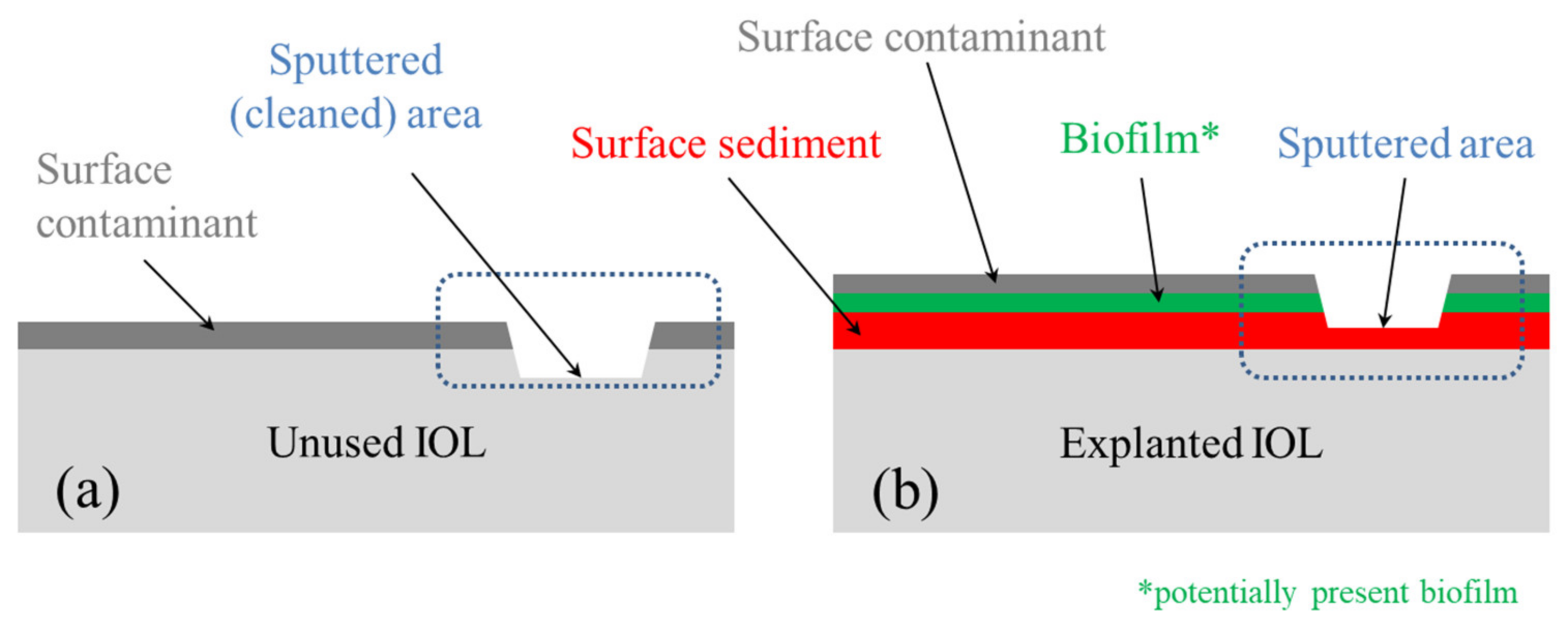

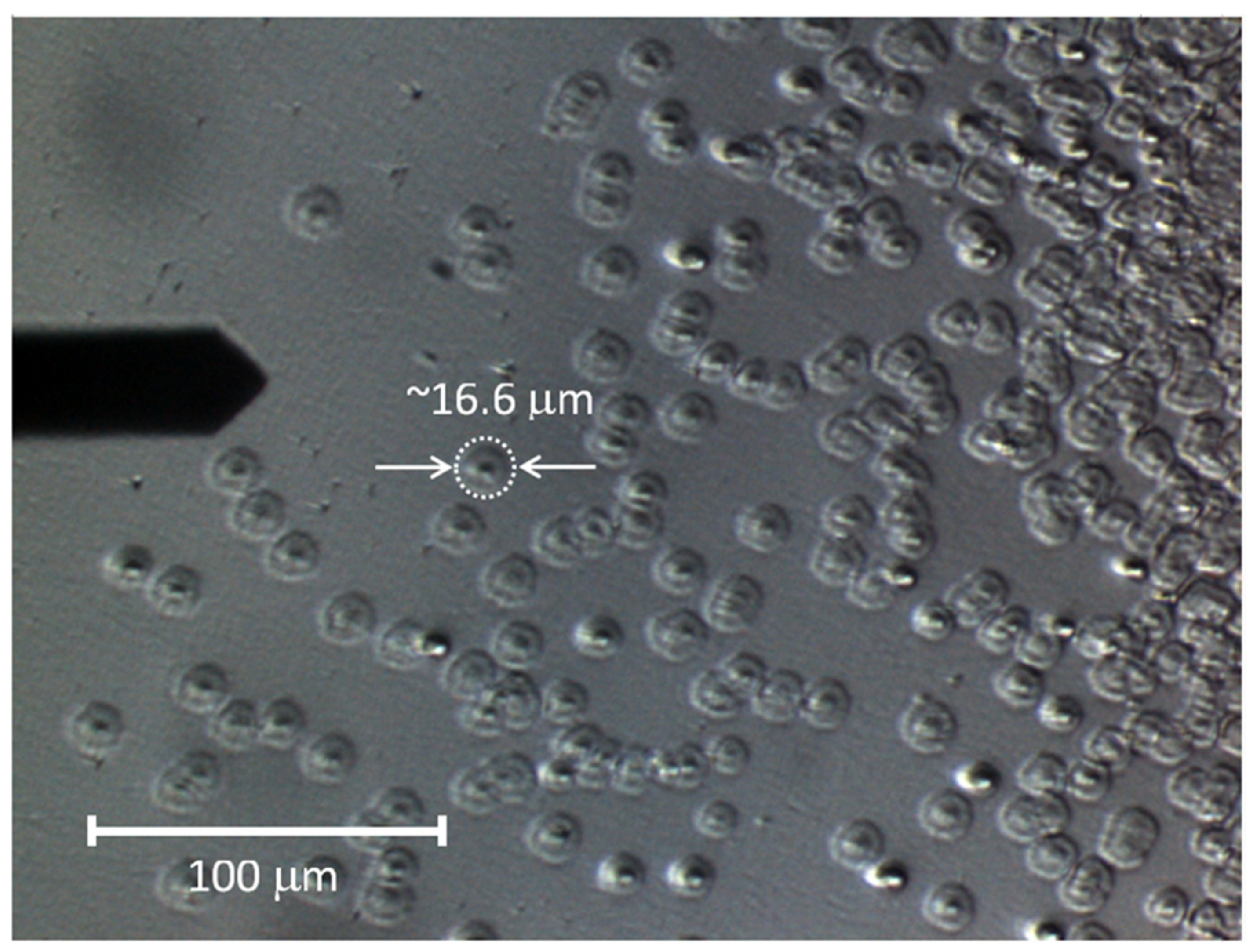
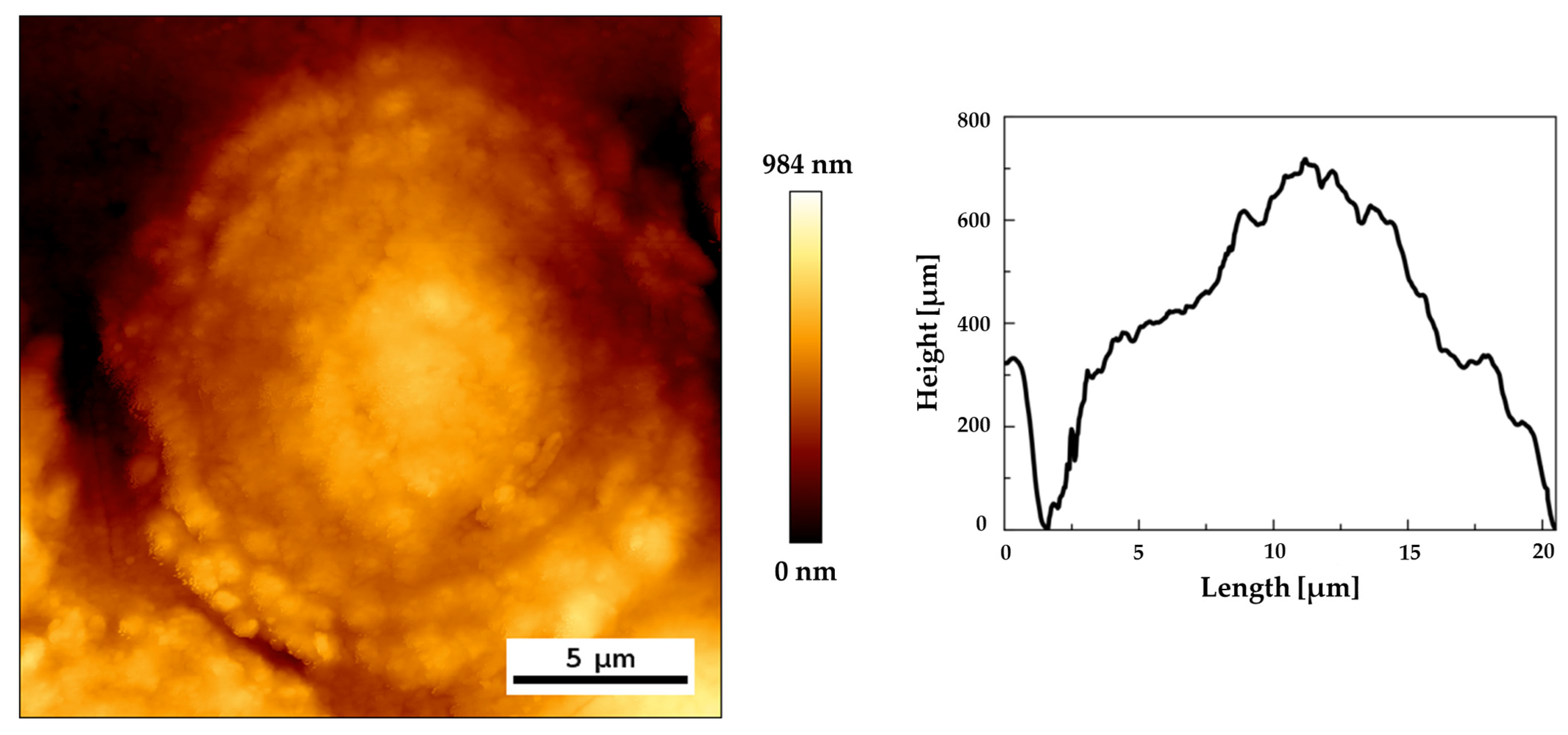
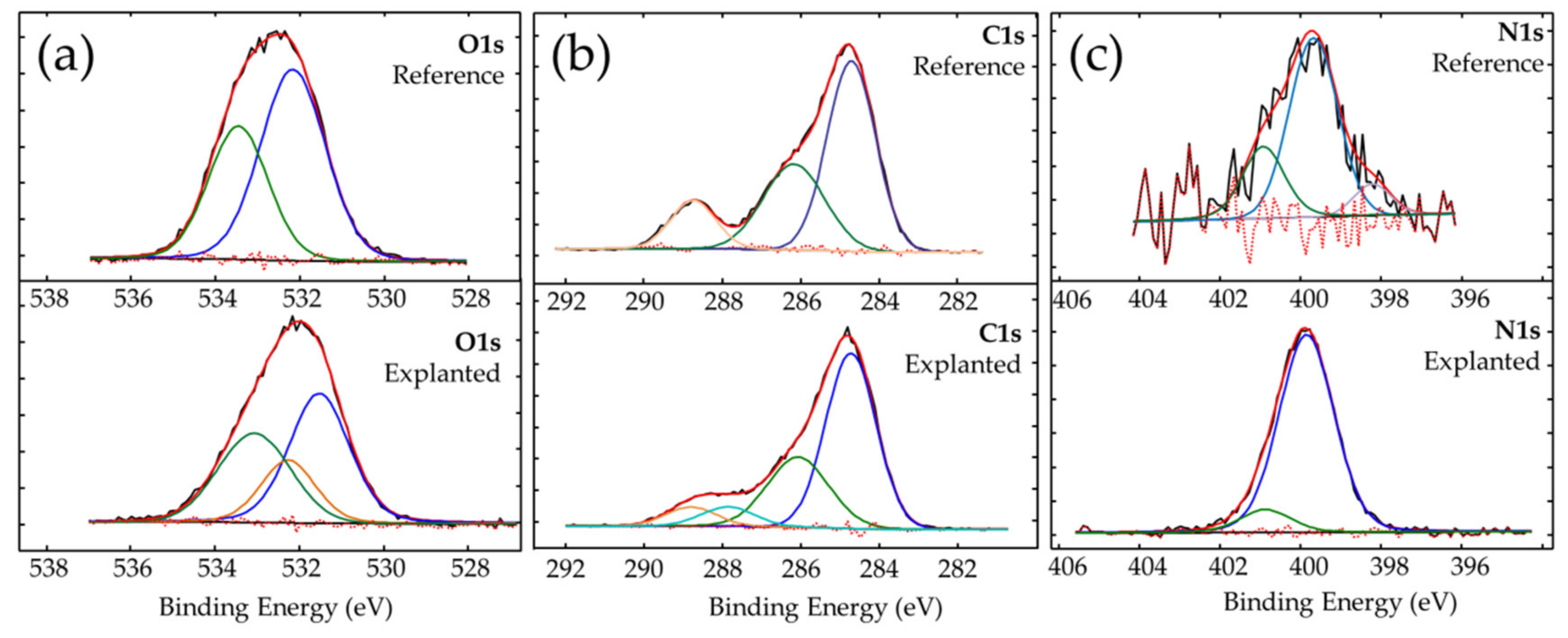

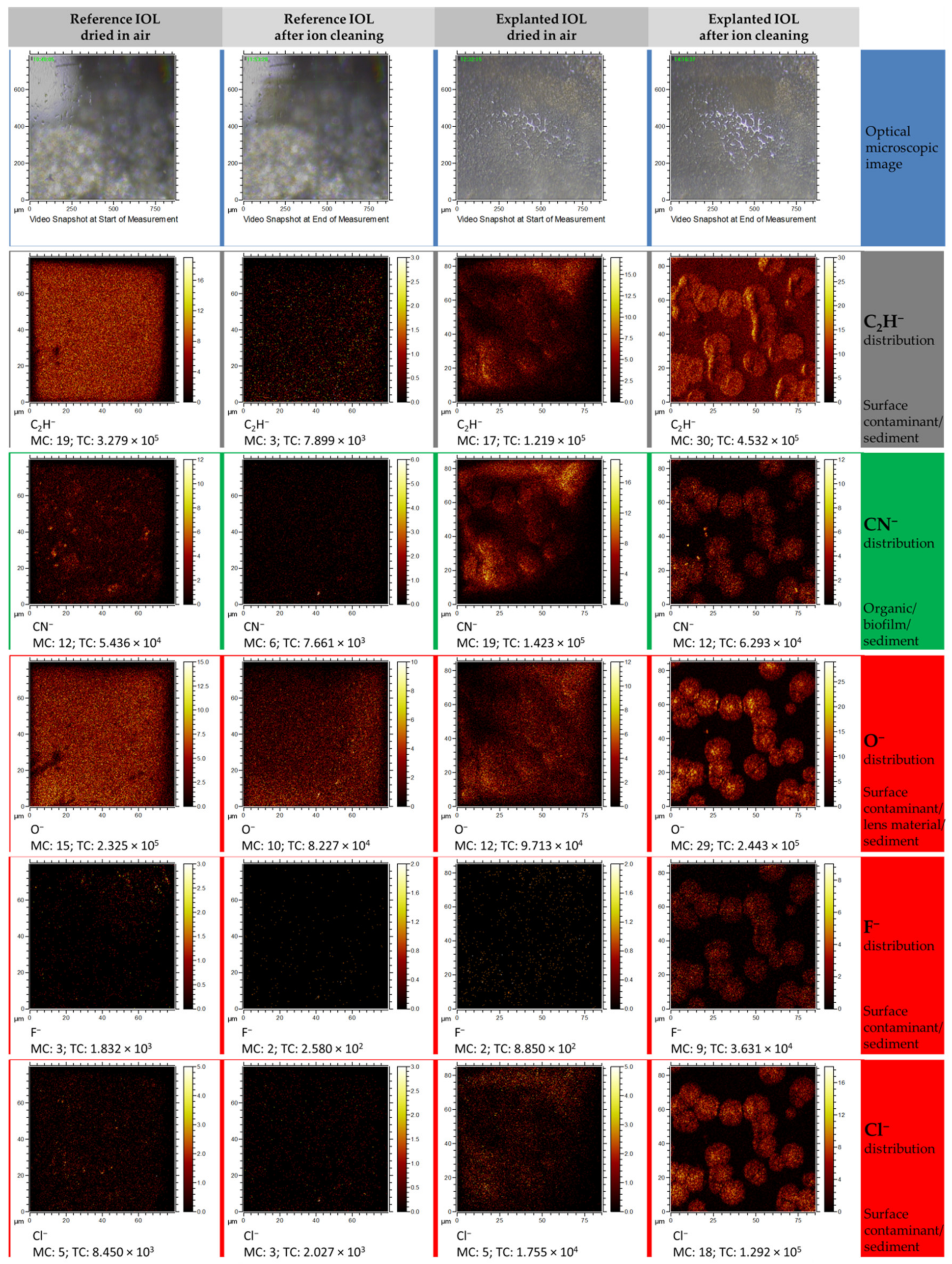
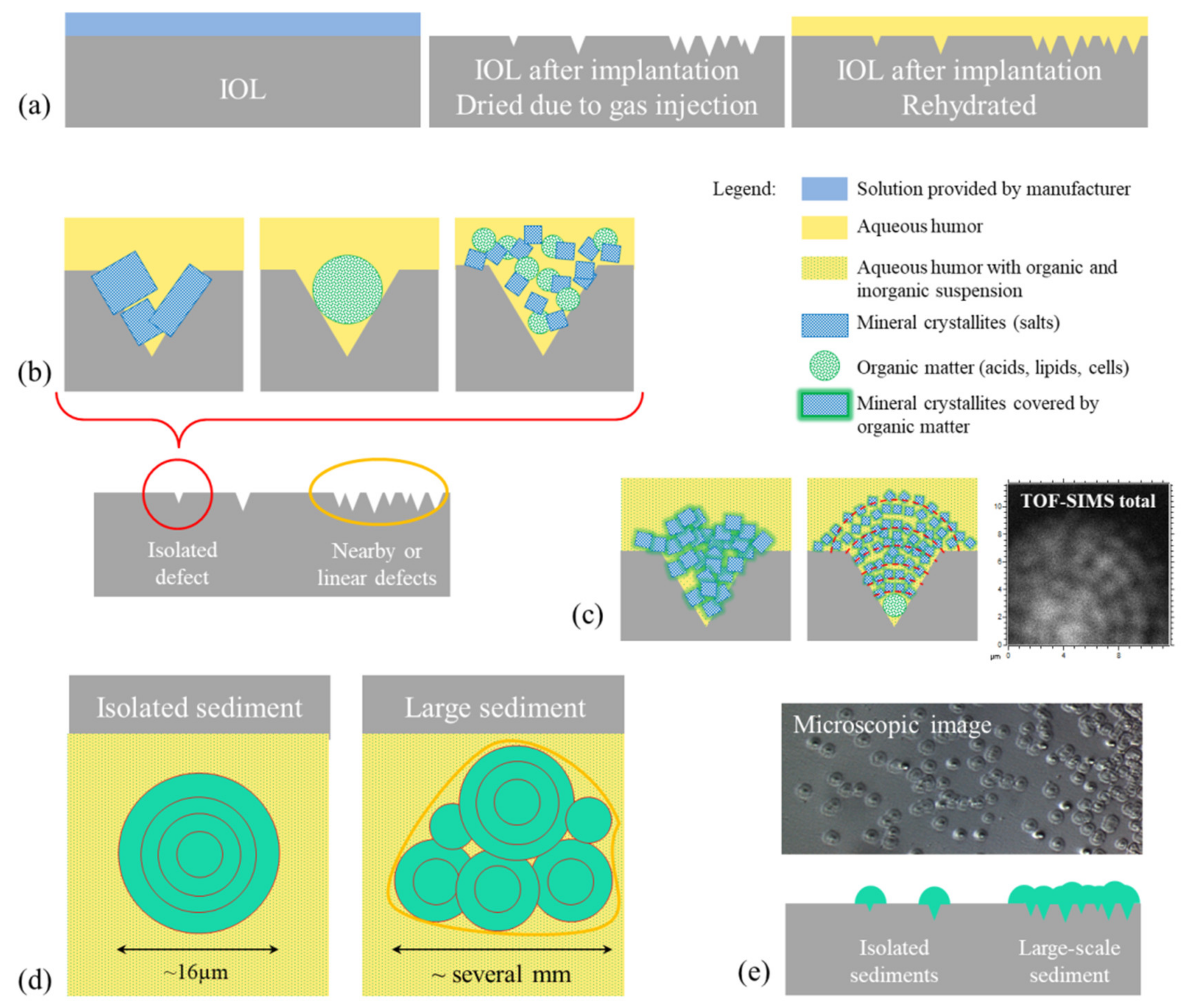

© 2020 by the authors. Licensee MDPI, Basel, Switzerland. This article is an open access article distributed under the terms and conditions of the Creative Commons Attribution (CC BY) license (http://creativecommons.org/licenses/by/4.0/).
Share and Cite
Tarnawska, D.; Balin, K.; Jastrzębska, M.; Talik, A.; Wrzalik, R. Physicochemical Analysis of Sediments Formed on the Surface of Hydrophilic Intraocular Lens after Descemet’s Stripping Endothelial Keratoplasty. Materials 2020, 13, 4145. https://doi.org/10.3390/ma13184145
Tarnawska D, Balin K, Jastrzębska M, Talik A, Wrzalik R. Physicochemical Analysis of Sediments Formed on the Surface of Hydrophilic Intraocular Lens after Descemet’s Stripping Endothelial Keratoplasty. Materials. 2020; 13(18):4145. https://doi.org/10.3390/ma13184145
Chicago/Turabian StyleTarnawska, Dorota, Katarzyna Balin, Maria Jastrzębska, Agnieszka Talik, and Roman Wrzalik. 2020. "Physicochemical Analysis of Sediments Formed on the Surface of Hydrophilic Intraocular Lens after Descemet’s Stripping Endothelial Keratoplasty" Materials 13, no. 18: 4145. https://doi.org/10.3390/ma13184145




